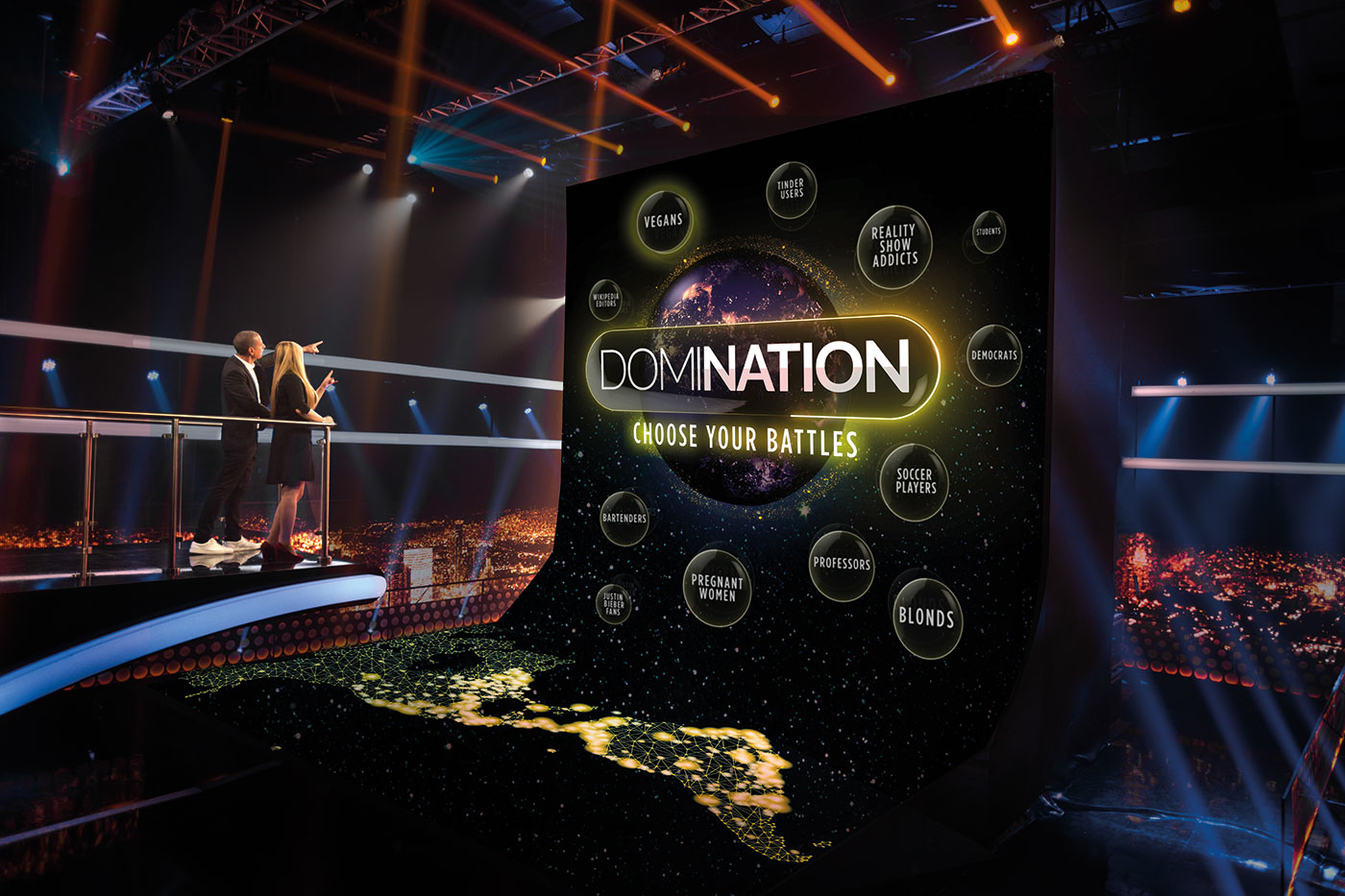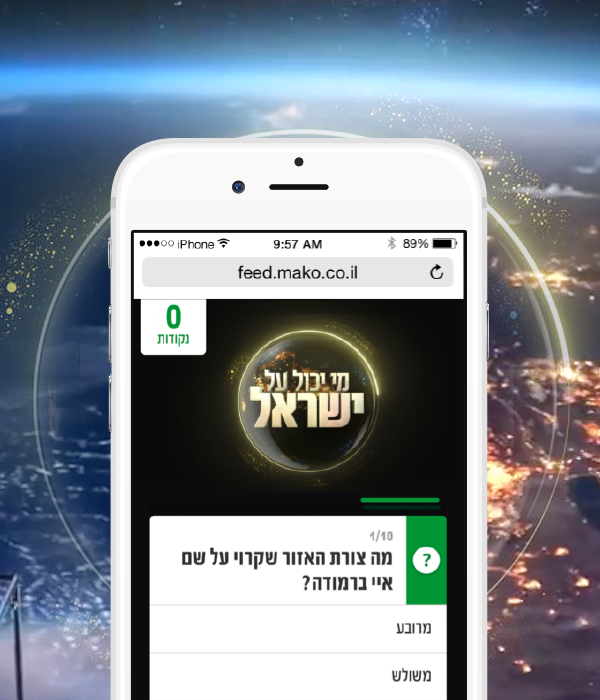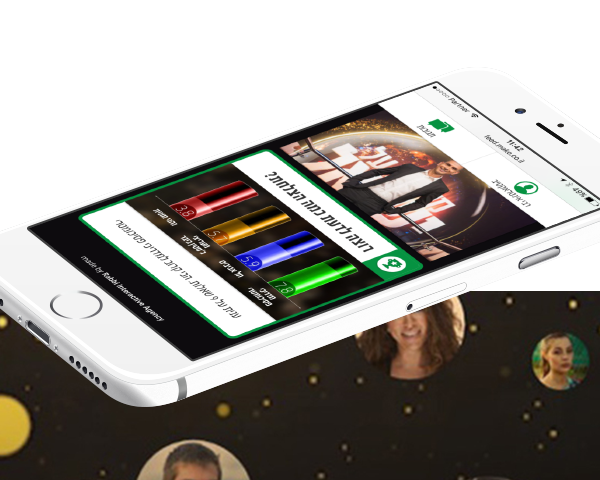The game that challenges the whole nation. Players must choose their battles wisely in this bold new national TV event where winning is about much more than delivering correct answers, it’s about playing with the right tactics! In Israel, the Tv show is called "Who Can Beat Israel?"

“Who Can Beat Israel” is the new generation of interactive television game shows where the viewers play a central part, and participate in the game from home. Right from the first planning meeting with Keshet and the project management team at Mako, we understood that even with all our rich experience in developing digital products for the second screen, this was a very unique product, and that we were very lucky, and maybe among the only ones in the world developing and producing products in this style.

“We Israelis think we know everything better than everyone else, so can one person beat a whole country?” Forget about what you know about quiz shows, the new television game show brought together, every time, the contestants in the studio with all of Israel and the viewers at home.
The game was divided into rounds, and in each round, the contestant was required to select a group he would compete against in the round, for example, Electric Company employees, students, etc. If the contestant in the studio managed to answer more questions correctly than the competing group, he moved on to the next stage, and on, until the final stage, and beat the whole country.
Domination Promo in Israel
Gil Rabbi, CEO of Rabbi Interactive
At the time of the broadcast, the viewers at home joined in and registered via the application and participated in the game in real time, in synchronization with the questions of the studio contestants. The special development of the push interface enabled the operator in the control room to watch the show while simultaneously controlling and sending new questions to the application for the viewers at home, so that at the moment the operator pressed the button in the studio, a new question immediately popped onto the screens of hundreds of thousand users at home.
In addition to the user experience of a digital product for viewers at home, we invested much thought into the construction of an easy-to-use interface for the program operator in the control room, as he needed to be able to see what was going on in the studio in real time, and also be able to operate the system and digital product quickly and simultaneously.
Viewers at home are invited to play against the contestant in the studio
The program management mechanism for the operator and the rounds interface
The specially-developed management mechanism enabled the producers and operators of the show to set up and build the program’s line-up, to send out content during the broadcast, and receive data directly to the management interface in real time regarding the number of people playing the games, leading participants, and more. In addition, the management interface enabled the operator to create new content during the broadcast itself and send it to the application, as in the case of a live broadcast, sometimes there were changes in real time or other constraints; the operator needed the flexibility to deal with changes in line-up and keep the viewers at home synchronized with what was happening in the studio at all times.
Every stage of product development and every few lines of code were analyzed and checked for “overload”. We use the best development languages and methods to create a dynamic and variable digital product, but still a product that is light on resource consumption.
During product development, we designed and set up infrastructure, a special smart server environment at Amazon’s cloud company, with support from representatives of Amazon Israel who have been working with us for several years in the field of the second screen. The environment that we set up was dynamic and enabled us to support hundreds of thousands of users playing simultaneously, and even be flexible enough during the show to support thousands more viewers who might join in during the show.
When product development ended, we carried out a pilot and comprehensive load testing simulating millions of users playing along with us in real time, registering, answering questions, refreshing the page, entering and exiting, and other extreme situations, on the management interfaces.
Eyal Kitzis explains about using the product on Facebook
Real-time data to the situation room
As part of developing the product, we developed a statistics mechanism for real-time export of data from the system to the show’s situation room, so During the program, the MC Eyal Kitzis turned to Liron Weizman in the situation room, and the viewers at home received updates regarding their results, leading viewers who managed to answer the most questions correctly, and receive more data statistics from the viewers at home using the application.
Real-time export of the data was another challenge as, in contrast with standard digital products, here we had large quantities of data received in real time being broadcast live. any delays could lead to displaying data that’s not up-to-date. Therefore, careful thought and smart development of the product was required so that large quantities of data could be processed in real time.
חדר המצב שהציג נתונים בזמן אמת
The ability to deal with malfunctions during a live broadcast
In contrast with standard digital products, where when a malfunction is reported it’s possible to perform analysis and upload a new, fixed version, with products for the second screen, the ability to fix and solve coding problems is almost nil, as hundreds of thousands of users are using the product in real time, the show is on TV – everything’s happening here and now and there’s no second chance. So beyond the fact that we performed rigorous and meaningful QA processes, we learned, planned, and built various situation that may occur during the broadcast, and we constructed ready scenarios of the way to deal with a variety of malfunctions. Of course, it’s not possible to predict everything and manage to prepare for all possible scenarios, but our ability to deal with problems was very high, and that was a significant part of the project.
We developed smart mechanisms that enabled us to monitor the use of the digital product by viewers at home, how quickly the product was uploaded to the viewers, for how many of the hundreds of thousands of participants the product did not work properly, and more.
During broadcast time itself, we monitored the server environment, the databases, and the level of traffic generated at any given time, all under a security system for checking the integrity of the players participating from home.
Practice Games
Ahead of the program launch by Keshet, we released practice games. This was a digital product with a user experience identical to that of the live broadcast product, but unlike the live broadcast where the product was synchronized with what’s happening in the studio, the practice games allowed the user to play at his own pace, and practice for the show. The practice games were promoted on the Mako site by commercials on Keshet.


